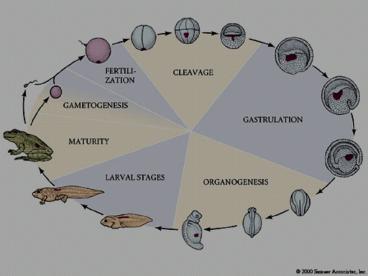Egg of toad - PowerPoint PPT Presentation
1 / 49
Title: Egg of toad
1
(No Transcript)
2
Egg of toad
3
(No Transcript)
4
Cleavage
5
Axis of cleavage
6
Gastrulation
- Gastrulation carried out byMigration of cells
from the surface Toward the blastopore (epiboly),
followed By invagination and involution. - The result is the formation of three germ layers
- Outre ectoderm.
- Middle mesoderm.
- Inner endoderm.
7
(No Transcript)
8
(No Transcript)
9
(No Transcript)
10
(No Transcript)
11
(No Transcript)
12
(No Transcript)
13
(No Transcript)
14
(No Transcript)
15
(No Transcript)
16
(No Transcript)
17
Embryonic Development of Birds
- Fertilization Internal.
- Type of egg
- According amount of yolk Polylecithal type.
- According to distribution of yolk heavy
telolecithal type. - Kind of cleavage Discoidal cleavage.
18
Female genital System
19
(No Transcript)
20
- Cleavage
- 1st cleavage Vertical and give two blastomeres.
- 2nd cleavage At right angle to the first and
give 4 blastomeres. - 2rd cleavage Is radial at right angle to the
second. - 4th cleavage Central arround the apical end of
the eight blastomeres. - The cleavage proceeds with irregular manners with
increased in the number of cells and spread over
the surface of the yolk.
21
(No Transcript)
22
(No Transcript)
23
- Formation of Blastula
- The blastomeres spread over the yolk surface
with closely attachement to the yolk by both ends
and the zone of attachement called zone of
junction. The blastocoele is reduced and is
called subgerminal space or segmentation cavity. - Formation of Gastrula
- The blastoderm cells arranged in different
cell layers. The innermost cell layers separated
by a process called delamination forming outer
epiblast and inner hypoblast which is known
afterwords the ectoderm and endoderm. - Or by different process of cell movements called
- Emboly convergence , invagination involution.
- Epiboly include overgrowth of the ectoderm and
endoderm over the yolk mass.
24
(No Transcript)
25
(No Transcript)
26
(No Transcript)
27
(No Transcript)
28
(No Transcript)
29
Embryonic Development of human
- Fertilization Internal.
- Type of eggs Alecithal type.
- Type of cleavage Equal holoblastic.
- Cleavage
- Ist occurs at right angles to imaginary axis
and results in the formation of two blastomeres
after 36-46 hours . The embryo still surrounds by
zona pellucida to make close contact of the
blastomeres. - 2nd Occurs at prependicular axis at 60 hours
and result in the formation of 4 blastomeres. - 3rd Occurs at 70 hours and result in the
formation of 8 blastomeres. - At 72 hours The morula stage is formed and
composed of 12 cell stage.The peripheral cells is
called trophoblast and formed of 11 cells and the
12th cell is very large and enclosed in the
center and called inner cell mass. - At 4 days 58 cell embryo is formed . The outer
periphery trophoblast cells is formed of 53
blastomeres. The inner cell mass composed of 5
large cells. - At 4.5-5 days 107 cell stage is formed with
peripheral trophoblast cells composed of 99 cells
and inner cell mass composed of 8 formative cells
(inner cell mass).
30
- Implantation
- At the 6th day , the zona pellucida become
lysed after the blastula reached to the proper
side of the endometrium . The trophoblast cells
exert microvilli which intern exert a histolytic
action on the endometrium epithelium facilitating
penetration and implantation . By the end of 8
days implantation is completed. After
implantation the eendometrium is closed by fibrin
clott. Implantation occurred at the posterior
wall of the uterine tube near the fundus. - Abnormal site of implantation (Ectopic
pregnancy) - Tubal pregnancy.
- Ovarian pregnancy.
- Abdominal pregnancy.
31
- Gastrulation
- The inner cell mass divides into several cell
layers. The outer is the ectoderm. The middle is
mesoderm . The inner is the endoderm. - Periods of pregnancy
- First trimester First 3 months.
- Second trimester Middle 3cmonths.
- Third trimester The last 3 months.
32
(No Transcript)
33
(No Transcript)
34
(No Transcript)
35
(No Transcript)
36
(No Transcript)
37
(No Transcript)
38
(No Transcript)
39
(No Transcript)
40
(No Transcript)
41
(No Transcript)
42
(No Transcript)
43
(No Transcript)
44
Embryonic Membranes
- Found only in amniotic animals and formed mainly
of 4 types - A mnion.
- Chorion.
- Allantois.
- Yolk Sac.
45
(No Transcript)
46
(No Transcript)
47
(No Transcript)
48
(No Transcript)
49
(No Transcript)































